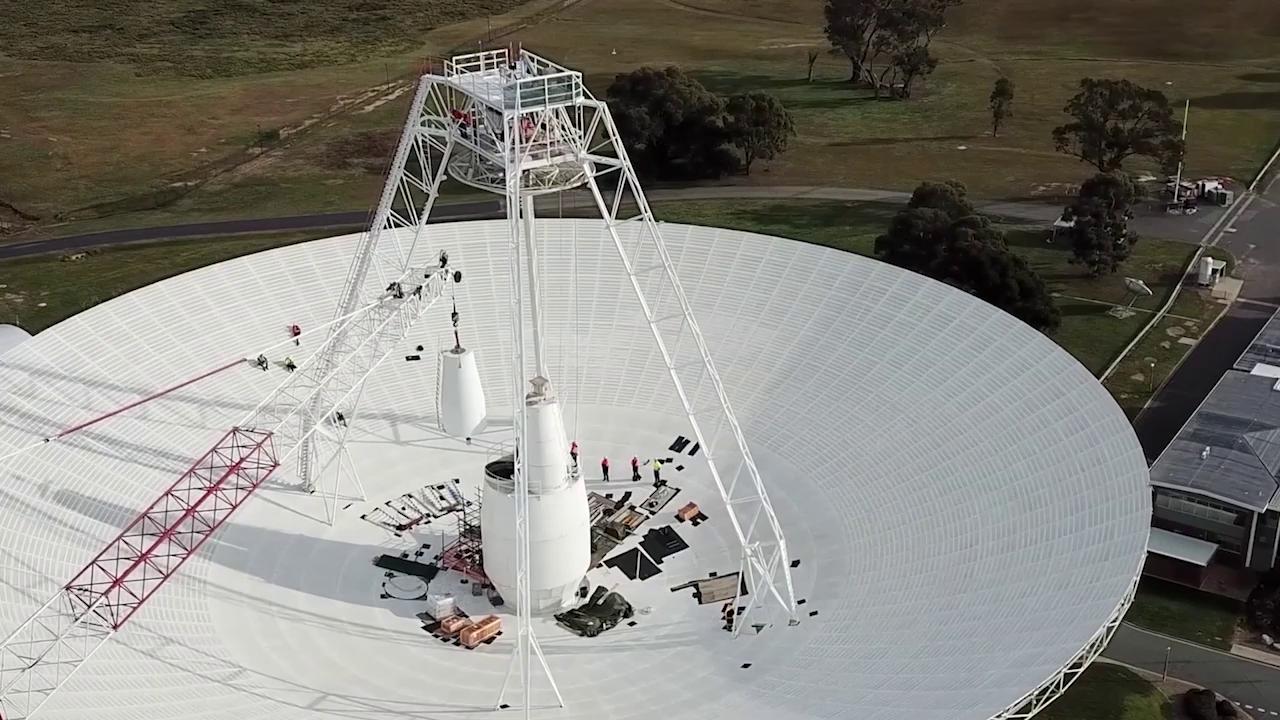

Crews conduct critical upgrades and repairs to the 70-meter-wide (230-foot-wide) radio antenna Deep Space Station 43 in Canberra, Australia. In this image, one of the antenna's white feed cones (which house portions of the antenna receivers) is being moved by a crane. Credit: CSIRO
“Voyager 2, this is Earth calling. Do you read?”
Last week, the answer was finally “yes.” And thankfully, after eight months of no communications, Voyager2 seems to be just fine.
On October 29, NASA’s Deep Space Network communicated with the Voyager 2 spacecraft for the first time since March of this year. The only radio antenna powerful enough to send and receive the faint signals from the 43-year-old spacecraft is the 70-meter-wide (230-foot-wide) Deep Space Station 43 dish in Canberra, Australia. But the behemoth radio dish has been offline for repairs and upgrades.
The communications last week were part of a test of the new hardware, but the upgrades aren’t finished yet.
“The work has not been completed on DSS43,” said Richard Stephenson on Twitter. Stephenson works in the Operations at Canberra Deep Space Communication Complex. “Shortly after confirming a good command link with Voyager 2 the engineering team went back to work on more structural upgrades. The antenna still has to be optimized for X-Band which needs clear skies and a couple of weeks work.”
NASA said they expect the work to be wrapped by in February 2021. Currently, it takes about 17 hours and 25 minutes for a signal to reach Voyager 2, and then then same amount of time for the spacecraft to send a signal back to Earth (You can see the current data on the two Voyager spacecraft here.)
During the repairs, Voyager 2 has been “flying solo,” based on the final commands it received before the Canberra dish was taken offline. Voyager 2 returned a signal confirming it had received the “call” and executed the commands without issue.
Among the upgrades to DSS43 are two new radio transmitters. One of them, which is used to talk with Voyager 2, hasn’t been replaced in over 47 years. Engineers have also upgraded heating and cooling equipment, power supply equipment, and other electronics needed to run the new transmitters.
“What makes this task unique is that we’re doing work at all levels of the antenna, from the pedestal at ground level all the way up to the feedcones at the center of the dish that extend above the rim,” said Brad Arnold, the DSN project manager at NASA’s Jet Propulsion Lab. “This test communication with Voyager 2 definitely tells us that things are on track with the work we’re doing.”
The Deep Space Network consist of radio antenna facilities spaced equally around the world. They are located in Canberra; Goldstone, California; and Madrid, Spain. The positioning of the three facilities ensures that almost any spacecraft with a line of sight to Earth can communicate with at least one of the facilities at any time.
However, the dish in Canberra is the only one capable of communicating with Voyager 2. In order to make a close flyby of Neptune’s moon Triton in 1989, the probe flew over the planet’s north pole. That trajectory deflected it southward relative to the plane of the planets, and it has been heading in that direction ever since. Now more than 11.6 billion miles (18.8 billion kilometers) from Earth, the spacecraft is so far south that it doesn’t have a line of sight with radio antennas in the Northern Hemisphere.
The upgrades for DSS43 will be beneficial for other deep space missions, too, especially for the landing of the Perseverance rover on Mars on February 18, 2021.
On December 27th, 2024, the Chilean station of the Asteroid Terrestrial-impact Last Alert System (ATLAS)…
On December 3rd, 2018, NASA's Origins, Spectral Interpretation, Resource Identification, and Security-Regolith Explorer (OSIRIS-REx) successfully…
The Andromeda Galaxy, our nearest large neighbour, has 36 identified dwarf galaxies. The Hubble telescope…
Rogue planetary-mass objects, also known as free-floating planets (FFPs) drift through space alone, unbound to…
The effects of Climate Change on Earth's living systems have led to a shift in…
Our Milky Way Galaxy is rich in dark matter. The problem is, we can't see…